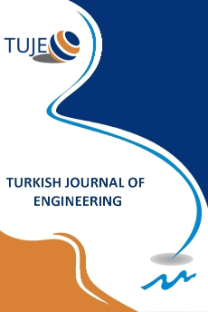CRITICALITY CALCULATION OF A HOMOGENOUS CYLINDRICAL NUCLEAR REACTOR CORE USING FOUR-GROUP DIFFUSION EQUATIONS
CRITICALITY CALCULATION OF A HOMOGENOUS CYLINDRICAL NUCLEAR REACTOR CORE USING FOUR-GROUP DIFFUSION EQUATIONS
four-group diffusion equation, effective multiplication factor, mesh size, reactor, Criticality calculation,
___
- Atomic Energy Control Board of Canada, Fundamental of Power Reactors. Canada: Atomic Energy Control Board of Canada (AECBC), pp. 1-3, 1993. Available [online]: http://www.thecanadianencyclopedia.ca/en/article/atomic-energy-control-board/
- A. Arzhanov, Analytical Models of Critical Reactor in Simple Geometries. Royal Institute of Technology, Department of Physics. Stockholm, Sweden: KTH Engineering Sciences, pp. 1-33, 2010.
- B. Ganapol, Verification of the CENTRM Module for Adaptation of the SCALE Code to NGNP Prismatic and PBR Core Designs, Univeristy of Arizona. Arizona: Reactor Concepts RD&D, 2014.
- D. B. Ganapol, The Analytical Solution to the Multigroup Diffusion Equation in One - Dimensional Plane, Cylindrical and Spherical Geometries, Joint International Tropical on Mathematics and Computation and Supercomputing in Nuclear Application, 2007.
- J. D. Burnham, Reactor Theory - The Steady State, Nuclear Training Course, 1967.
- J. J. Duderstadt and J. L. Hamilton, Nuclear Reactor Analysis. Michigan: John Wiley & Sons, Inc, 672p, 1976.
- J. T. Urbatsch, Iterative Acceleration Methods for Monte Carlo and Deterministic Criticality. California: Los Alamos National Laboratory, pp. 1-174, 1995. Available [online]: https://www.osti.gov/scitech/servlets/purl/212566
- J. Kiusalaas, Numerical Methods in Engineering with Matlab, New York: Cambridge University Press, pp. 1-435, 2005.
- M. A. Jayeola, M. K. Fasasi, A. A. Amosun, A. O. Salau, B. M. Ojo (2018), Numerical Computation of Fission-Product Poisoning Build-up and Burnup Rate in a Finite Cylindrical Nuclear Reactor Core, Bilge International Journal of Science and Technology Research, Vol. 2(1), pp. 17-30.
- M. S. Stacey, Nuclear Reactor Physics. Atlanta: Wiley-Vch Verlag Gmbh & Co. KGaA, Weinheim, 735p., 2007.
- R. J. Larmash and J. A. Baratta, Introduction to Nuclear Engineering (3rd edition), New Jersey, 420p., 2001.
- T. Tanbay and O. Bilge, Numerical Solution of the Multigroup Neutron Diffusion Equation by the Meshless RBF Collocation Method, Mathematical and Computational Applications, Vol. 18, pp. 399-407, 2013.
- W. H. Harman, Modelling Pressurized Water Reactor Kinetics, Ohio, Wright-Patterson Air Force Base, 2001.
- ISSN: 2587-1366
- Yayın Aralığı: 4
- Başlangıç: 2017
- Yayıncı: Mersin Uüniversitesi
COMPARATIVE STUDY OF REGIONAL CRASH DATA IN TURKEY
Babatunde Michael OJO, Musibau Keulere FASASİ, Ayodeji Olalekan SALAU, Stephen Friday OLUKOTUN, Mathew Ademola JAYEOLA
INVESTIGATION OF Ni-Mn BASED SHAPE MEMORY ALLOY VARIATIONS TRANSFORMATION TEMPERATURES
